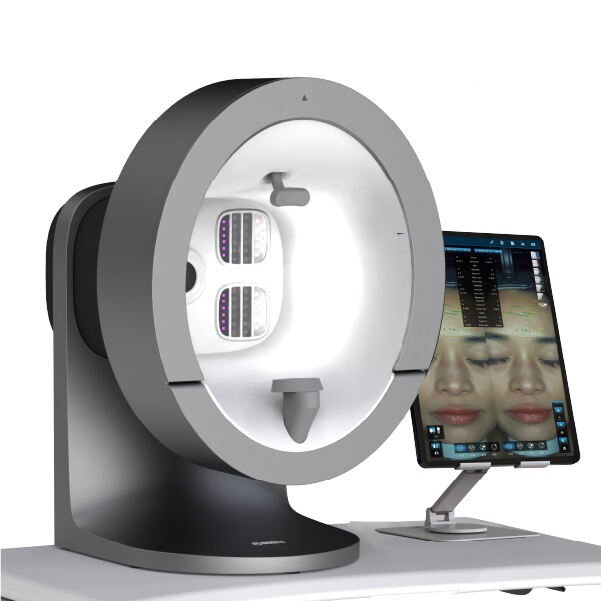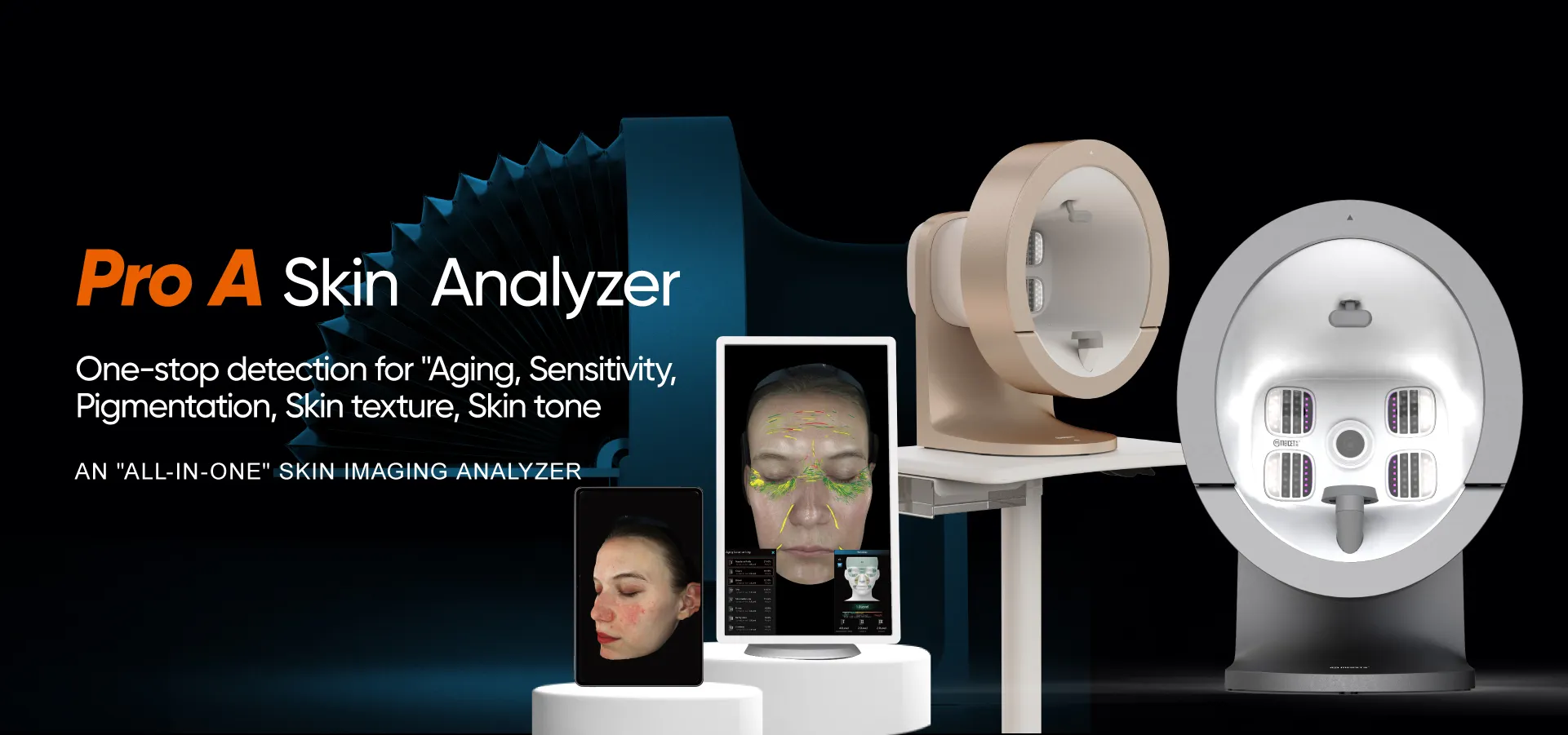
Anti-aging treatments—from retinoids and chemical peels to laser resurfacing—are powerful tools for reducing wrinkles, improving texture, and restoring radiance, but they pose unique challenges for sensitive skin. Sensitive skin’s compromised barrier function and heightened reactivity increase the risk of irritation, redness, or even paradoxical worsening of signs of aging (e.g., inflammation-induced pigmentation). For clinicians, the goal is to balance efficacy with safety, crafting regimens that deliver results without disrupting the skin’s delicate equilibrium. MEICET’s Pro-A Skin Imaging Analyzer, with its AI-driven analysis, bridges this gap by measuring both aging signs and sensitivity markers, enabling the design of anti-aging plans that are targeted, gentle, and effective.

Identifying Aging-Sensitivity Interactions
Sensitive skin ages differently than resilient skin, with unique interactions between barrier health, inflammation, and visible signs of aging. The Pro-A’s AI integrates multi-spectral data to map these relationships, providing a nuanced understanding of the skin’s needs:
- Wrinkle assessment via RGB imaging distinguishes between fine lines caused by dryness (which respond to hydration) and deep creases rooted in collagen loss (which require targeted collagen stimulation). For example, periorbital lines in sensitive skin may appear more prominent due to barrier weakness—RGB scans can flag these as “dryness-related,” guiding moisturization before introducing actives.
- Barrier function via UV imaging measures the stratum corneum’s integrity, with irregular patterns indicating areas where actives like retinoids or alpha-hydroxy acids (AHAs) might cause irritation. The AI identifies “barrier zones,” highlighting high-risk areas (e.g., cheeks) that need gradual introduction of actives versus more resilient areas (e.g., forehead) that can tolerate earlier treatment.
- Inflammation markers via polarized light imaging detect subclinical redness or vascular dilation, signaling areas where anti-aging treatments might trigger flares. This is particularly important for conditions like rosacea, where inflammation can exacerbate collagen breakdown and worsen wrinkles over time.
Consider a patient with sensitive skin presenting with crow’s feet, dullness, and a history of post-product redness. Pro-A scans reveal: RGB showing fine lines around the eyes with evidence of dryness (shallow, feathery patterns), UV imaging indicating barrier weakness across the cheeks (irregular fluorescence), and polarized light highlighting mild vascular activity on the nose (early rosacea signs). The AI synthesizes this data to identify priorities: first strengthen the barrier, then address dryness-related lines, and finally introduce gentle collagen-stimulating treatments—avoiding retinoids or high-concentration AHAs that could trigger inflammation.
Customizing Treatment Sequences
AI analysis enables clinicians to phase anti-aging treatments strategically, building tolerance and minimizing risk:
- Phase 1 (Barrier Repair): For patients with compromised barriers (evident in UV scans), the AI recommends focusing on ceramide-rich moisturizers, anti-inflammatory serums (e.g., green tea extract), and gentle cleansers. Follow-up scans later track UV uniformity—improvement signals the skin is ready for the next phase. A patient with initially poor barrier function might show better UV uniformity after consistent use of this regimen, confirming readiness to proceed.
- Phase 2 (Gentle Actives): Once barriers stabilize, the AI suggests introducing low-strength, slow-release actives. For example, mild retinol (applied occasionally) paired with niacinamide to support barrier function. RGB imaging monitors wrinkle response (e.g., softening of fine lines), while polarized light checks for inflammation—guiding adjustments to frequency or concentration.
- Phase 3 (Targeted Treatments): For persistent signs, the AI guides selective use of lasers or peels, focusing on resilient areas and avoiding sensitive zones. For instance, a fractional laser with low energy might be used on the forehead (stronger barrier) to improve texture, while the cheeks (weaker barrier) continue with topical treatments.
A patient with sensitive skin and mid-face wrinkles might progress through these phases over time: starting with barrier repair (ceramides + anti-inflammatories), advancing to mild retinol used occasionally, and finally adding periodic low-fluence laser sessions to the cheeks—with Pro-A scans confirming no inflammation at each step. This gradual approach delivers visible improvement (softer wrinkles, brighter tone) without compromising skin health.
Predicting and Preventing Irritation
The Pro-A’s AI leverages historical data to anticipate potential reactions, enabling proactive adjustments:
- For patients with a history of post-retinol redness, AI analysis of polarized light scans from previous treatments identifies “high-risk zones” (e.g., malar eminences) where irritation is most likely. The AI recommends avoiding these areas initially or diluting the retinol with moisturizer when applied there.
- For laser candidates, the AI correlates UV barrier data with past inflammatory responses to predict tolerance. Patients with consistently compromised barriers in UV mode receive lower fluence settings and longer intervals between sessions, while those with stronger barriers can tolerate standard parameters.
- For chemical peels, the AI analyzes RGB texture and UV barrier data to recommend appropriate peel depth: superficial peels (e.g., lactic acid) for sensitive skin with barrier issues, versus medium-depth peels (e.g., glycolic acid) for more resilient skin.
In one case, a patient with sensitive skin and periorbital wrinkles expresses interest in a chemical peel. Pro-A scans show UV barrier weakness around the eyes and polarized light redness on the cheeks. The AI recommends a superficial lactic acid peel limited to the forehead and chin (stronger barrier areas), with the eye area addressed via topical peptides instead—preventing irritation while still delivering anti-aging benefits.
The Pro-A’s AI-driven analysis transforms anti-aging care for sensitive skin from a risky guessing game to a targeted, predictable process. By measuring the interplay between aging signs and sensitivity, phasing treatments strategically, and anticipating reactions, it empowers clinicians to deliver the rejuvenating results patients desire—without compromising the skin’s health or comfort.
 EN
EN
 AR
AR
 BG
BG
 HR
HR
 CS
CS
 DA
DA
 NL
NL
 FI
FI
 FR
FR
 DE
DE
 EL
EL
 HI
HI
 IT
IT
 JA
JA
 KO
KO
 NO
NO
 PL
PL
 PT
PT
 RO
RO
 RU
RU
 ES
ES
 SV
SV
 TL
TL
 IW
IW
 ID
ID
 SR
SR
 SK
SK
 SL
SL
 UK
UK
 VI
VI
 SQ
SQ
 HU
HU
 TH
TH
 TR
TR
 FA
FA
 AF
AF
 MS
MS
 UR
UR
 BN
BN
 LA
LA

